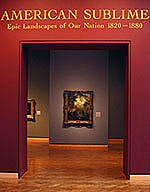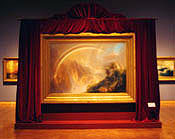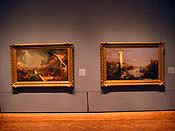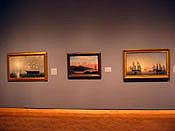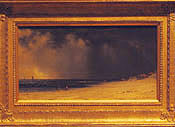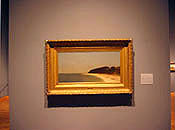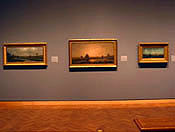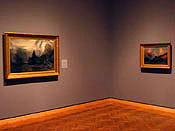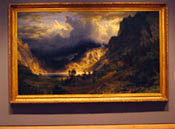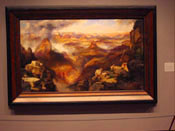The browser will either open the file, download it, or display a dialog.
|
"American Sublime: Landscape Painting in the United States, 1820–1880" Andrew Wilton and Tim Barringer |
|||||||||
|
No image could have been more fitting to welcome visitors to the recent "American Sublime" exhibition at The Minneapolis Institute of Arts than Asher B. Durand's Kindred Spirits. Painted in 1849, this classic work exemplifies America's early dedication to its native landscape as a defining image of an emerging national culture (fig. 1). As an introduction to this exhibition, Kindred Spirits is both a cherished, familiar image and a synopsis of the core characteristics associated with early nineteenth-century landscape painting in the United States. Compositionally, Durand used techniques inherited from the idealized seventeenth-century landscapes of Claude Lorraine, but the sensibility is decidedly contemporary and romantic. In fact, Kindred Spirits is a tribute to his friend and fellow painter Thomas Cole, who died unexpectedly in 1848, and the poet William Cullen Bryant, a close friend of both Cole and Durand. The dual portrait of painter and poet in the pristine Catskill Mountains setting speaks to the importance that this generation of artists felt for the untouched natural beauty of the American landscape, as well as the reverence they expressed for wild, awe-inspiring imagery. |
||||||||||
|
The exhibition was organized by the Tate Britain and traveled to the Pennsylvania Academy of the Fine Arts before arriving at The Minneapolis Institute of Arts, its final venue. The curators of the exhibition, Andrew Wilton, Keeper and Senior Research Fellow at the Tate Britain, and Tim Barringer, Assistant Professor, Department of the History of Art at Yale University, offered a fresh perspective by presenting this material as a dialogue between British and American landscape painting. This approach demonstrates the dependence of American painters on British pictorial traditions, as well as their eventual departure from those conventions in pursuit of a vision better suited to their native environment. The design of the exhibition followed the thematic structure of the catalogue, with each gallery devoted to a specific concept such as wilderness, transcendentalism, or exploration. In Minneapolis, the exhibition was designed around a muted palette of grays, blues, plums, and greens that showcased the often-vibrant hues of the landscapes depicted in the paintings. This served the viewer well, as the background did not compete with the paintings. In addition, the use of freestanding wall panels at gallery entrances created a surprising rhythm as the viewer moved from one space to the next. In the case of Frederic Edwin Church's Rainy Season in the Tropics of 1866, the presentation was especially dramatic; the solitary wall panel swagged in burgundy velvet drapery enshrined the "Great Picture," just as the artist had originally exhibited it (fig. 2). Although the effect is not quite the same as seeing it in a gas-lit room in post-Civil War New York City, it was nonetheless an important attempt at educating contemporary viewers about the nature of the mid-nineteenth-century art market in the United States. Church labeled many paintings "Great Pictures" because they were large in both scale and concept; and because the tag line attracted a wide audience to his exhibitions. Meticulous attention to flora and fauna combined with a remarkable mastery of panoramic spaces enabled Church to articulate his belief that the natural world was a reflection of the divine. Some paintings, such as Rainy Season in the Tropics or Twilight in the Wilderness of 1860, may have had political overtones as well. Scholars, including co-curator Barringer, see both of these works as commentaries on the American Civil War. Twilight in the Wilderness, with its setting sun reflected in the blood-colored lake, is an intensely emotive image. Given its date of 1860 and Church's documented concerns about the growing strife between the North and South, it is understandable that this dramatic landscape can be interpreted as a premonition of war. Rainy Season in the Tropics, painted six years later, transports the viewer to a sunlit, rainbow-laden paradise, an expression of hope in post-war America. | |||||||||
| Didactic material for the exhibition drew from the catalogue and—with one unexplained exception—every painting had a detailed label. In spite of museum-world debates about whether or not to provide substantive labels, it would appear that viewers appreciate them thoroughly. There is also an advantage to layering didactic material such as labels, wall information plaques, and catalogue texts; it allows viewers to gradually deepen their understanding of the material as each level of information provides an increasingly detailed and scholarly critique. Viewers can choose to participate at whatever level suits them best. In this exhibition, a single theme defined each gallery, offering an intellectual structure for the display of the paintings. Rainy Season in the Tropics, for example, was included in a gallery dedicated to the theme of exploration, an appropriate context in which to present Church's South American paintings or his small oil sketches of the far north. | ||||||||||
|
For those familiar with American landscape painting, this exhibition provided the opportunity of experiencing an impressive range of well-known images. Seeing Thomas Cole's 1834–36 series The Course of Empire, for example, is an entirely different experience when all five paintings are seen together. Only then can the viewer appreciate the fact that the central image, Consummation (fig. 3), is much larger than the other four paintings. Details that are difficult to see in reproductions are more readily discernable as well. For example, the red-robed emperor returning from victorious conquest in Consummation stands out brilliantly in the original, whereas he appears only as a modest figure in even the best of reproductions. Stylistic changes are also more evident. Cole altered his technique in response to his subject, moving from the smoothly finished Claudean arcadia of The Pastoral to the scumbled paint of Desolation. Viewing all five paintings together prompts the question of interpretation. Certainly the artist intended his series as an allegory of empire building in general, but the question of whether or not it was also meant as a comment on specific empires must be asked. Throughout the exhibition, the didactic materials raise the comparison between the British Empire under Queen Victoria's rule and the American Empire that was being created by relentless expansion across the continent. Was Cole's allegory a cautionary tale for both nations? His disenchantment with industrialization was well known and, as Barringer notes in the catalogue (p. 52), Cole was also disillusioned with President Andrew Jackson's policies of territorial expansion and Indian "relocation." The untainted paradise of early America was succumbing to the lure of the steam engine just as Britain had—and Cole saw this as the destruction of deeply embedded American ideals. In his final painting of the series, Desolation, the artist reflected an unexpectedly grim outlook for a nation whose rhetoric promised life, liberty, and the pursuit of happiness. | |||||||||
|
|
||||||||||
| This is where American landscape painters of the nineteenth century part company with the British tradition that had sustained them initially. Issues of composition and technique take second place to the social and moral questions posed by the issue of slavery, the Indian Reform Act of 1830, the annexation of vast territories west of the Mississippi River, and the gradual realization that the colonization of the American west meant an end to the wilderness. For many artists, the question was not about evoking a pre-industrial agricultural world or celebrating the dynamism of speed and steam, but about the morality of intentionally destroying an untainted wilderness. As Thomas Cole noted in his diary on July 6, 1835: "The painter of American scenery has indeed privileges superior to any other; all nature here is new to Art" (quoted on p. 51). This very newness brought a unique set of responsibilities to the American artist, and as the century progressed, the question of what those were became more and more pressing. | ||||||||||
|
American landscape painters responded in a variety of ways. Church saw the landscape as an expression of a Christian God's divine plan for all eternity. He tried to represent the beauty of that universal design in his exquisitely detailed panoramic paintings such as Cotopaxi (fig. 4). His contemporary, Sanford Robinson Gifford, evoked the untamed, luminous world of Maine in The Wilderness of 1860, in which the only sign of human habitation is an Indian woman with a child on her back awaiting her husband as he glides home in a canoe. The image is carefully composed around Mount Katahdin, remote and serene against a gold-tinged sky. Like the woman on the shore, the viewer luxuriates, if only for a moment, in an American wilderness in which human beings lived in harmony with nature. | |||||||||
| Several artists who can only be tangentially described as painters of the sublime landscape—John Frederick Kensett, Fitz Hugh Lane (fig. 5), and Martin Johnson Heade—responded slightly differently. Their inclusion in the exhibition is appropriate only if one considers the metaphysical intensity of American transcendentalism to be an expression of the Sublime. The drama typically associated with the sublime landscape is missing here, replaced by an eerie calm. These painters also display new formal concerns that hint at the approaching modernist fascination with pattern and abstraction. An example of this is Heade's Thunderstorm at the Shore of 1870–71, a small oil sketch of a blackened sky against a golden beach with a retreating billow of white cloud in the distance (fig. 6). The figures and boats in the painting function neither like the staffage of Claude nor the allegorical figures of Cole. Rather, this painting recalls the direct observation of nature that characterized Barbizon images or perhaps even Gustave Courbet's seascapes. | ||||||||||
|
|
||||||||||
| John Frederick Kensett's Eaton's Neck, Long Island of 1872 exhibits an even greater concern with formal abstraction (fig. 7). The exaggerated horizontal format is mathematically sectioned into thirds, with the motionless green water of Long Island Sound occupying the bottom third of the left side of the composition. Balancing this element are a swath of chalky beach and a shrub-covered dune on the right, which are presented as flat shapes against the pale sky. On the horizon are barely perceptible white sails. Kensett moved into unexplored territory here, verging on pure abstraction; water, sky, and earth are fundamental elements rather than specific topographical details. This simplification of form and shape is likewise characteristic of Fitz Hugh Lane, an artist who worked in relative solitude in Gloucester, Massachusetts. His 1864 painting, Brace's Rock, Brace's Cove, illustrates a striking interplay of light and dark shapes silhouetted against the sky and water. Reflections in the water become solid, flat patterns of color and shape instead of the expected wavering forms. The solitary disintegrating sailboat stranded on the beach, traditionally a symbol of life's transience, is also an innovative structure built of intersecting horizontals of light and dark forms. It is tempting to speculate on whether or not the artist had knowledge of Japanese prints, which might have offered a source for this type of compositional organization. | ||||||||||
| No discussion of the exhibition would be complete without mentioning Martin Johnson Heade's series of paintings of the salt marshes along the New England coast, a subject that he revisited repeatedly from the late 1850s until the late 1870s (fig. 8). The basic elements in these paintings are haystacks, meandering streams, and vast open skies. All present some indication of human activity, whether in the form of an abandoned hay wagon or the figure of a fisherman or a farmer. In subject matter, Heade's paintings are distantly akin to Constable's inhabited agricultural landscapes or perhaps even Jean-François Millet's and Jules Breton's images of gleaners from the 1850s. In composition, however, there is the same insistent horizontality that is present in both Kensett's and Lane's paintings. The spare landscape and the geometrical purity of the haystacks suggest a search for an underlying structure in nature. Indeed, Heade moved the haystacks around like chessmen on a board defined by interlocking horizontal elements of earth and water. Seen as a series of paintings, it becomes clear that the haystacks are markers in space, formal elements that delineate the scale of this coastal landscape. | ||||||||||
| The final theme of "American Sublime" was the exploration of the western frontier. These outsized paintings depicting the dramatic landscapes of the American West offered a grand finale to an exhibition already filled with many grand gestures. The introductory label provided a supportive historical framework but, for the most part, the paintings spoke for themselves. | ||||||||||
|
In the context of this exhibition, the "West" begins in Minnesota. Thomas Moran's series of paintings based on Henry Wadsworth Longfellow's "Song of Hiawatha" resulted from the artist's 1860 trip to Lake Superior, where much of the poetic saga is set. In 1867-68, Moran painted his first image of Hiawatha using a dark charcoal palette highlighted only by sparse gleams of red to indicate campfires on the rocky shore of the great lake Gitche-gumee (fig. 9). The scene depicts a confrontation between the hero Hiawatha and the evil magician Megissogwon, who is shown as a shadowy giant perched on the rocky cliffs above the lake. This painting and its companion piece from the same time, Hiawatha and the Great Serpent, the Kenabeek, must be understood in the context of complex mid-nineteenth-century perceptions about Native Americans. In writing the "Song of Hiawatha," Longfellow intended to cast Native Americans in the heroic context of an epic poem modeled on the Finnish Kalevala, and it is crucial to remember that the poet neither visited the sites of his poem nor had any contact with living Native American culture. Moran, however, did visit Lake Superior and he based his landscapes on sketches from his trip. This problematic patchwork is further complicated by Moran's reliance on the stylistic technique of J. M. W. Turner. The intense atmospheric colors, particularly in Fiercely, the Red Sun Descending Burned his Way along the Heavens, painted in 1875, is a direct descendant of Turner's late paintings, such as his Slave Ship of 1840. Like the poem on which it is based, Moran's Hiawatha paintings are intended to capture a people and a way of life that were in rapid decline by mid-century, but they paid tribute to this sad chapter of American history with the tools of the colonizing culture. (A minor question about the Minneapolis installation is why the local setting of Longfellow's poem was not addressed in the didactic materials since Minnehaha Falls is less than five miles from The Minneapolis Institute of Arts.) | |||||||||
| "American Sublime" is equally rich in the work of Albert Bierstadt, who painted the natural wonders of the Colorado Rocky Mountains, Yosemite Valley, and Puget Sound in the 1860s. These pictures are enormous. They pull viewers into the landscape and overwhelm them with the grandeur of the towering mountains. Light pours through clouds to reveal an untouched wild beauty painted with great attention to topographical detail. Storm in the Rocky Mountains, Mount Rosalie of 1866 is typical (fig. 10). Storm clouds pile up in the distance, but brilliant light still streams through to illuminate the crystal water of the mountain lake. A copse of pine trees stands silhouetted against the gleaming, golden light, marking the center of the composition and giving the viewer a focal point in this awe-inspiring landscape. In the foreground, a dimly lit alpine meadow reveals the presence of human hunters chasing their fleeing quarry. A tiny Indian village appears in the lower left corner of the painting, thoroughly dwarfed by the surrounding environment. Like most of Bierstadt's landscapes, this one consists of elements taken from several locations, and the scale is considerably exaggerated. However, Bierstadt very capably captured the spirit of the West that had already become part of the American mythic consciousness by the 1860s. As Barringer notes in the catalogue, it was Bierstadt's paintings of Yosemite Valley that persuaded President Abraham Lincoln to sign into law the bill that would preserve it from development; similarly, it was Moran's images, together with William Henry Jackson's photographs, that convinced President Ulysses S. Grant to designate Yellowstone as a national park in 1872 (p. 60). | ||||||||||
| The exhibition concludes with a stunning composition by Moran (fig. 11). Painted in 1892, this vast canvas places the viewer at the top of the Grand Canyon, looking down on this magnificent natural phenomenon from mid-air. The sublime perspective of gazing up at Bierstadt's mountains has shifted to a position of physical superiority, surveying the land from above. The West had been won. | ||||||||||
| Janet L. Whitmore, Ph.D. Adjunct Assistant Professor College of Architecture and Landscape Architecture University of Minnesota |
||||||||||


